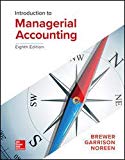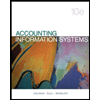
Traditional costing
In this costing system, a predetermined
Activity-based costing In this costing system, certain activities are identified (which give rise to indirect costs), costs are first allocated to these activities and then to products.
Unit product cost under traditional costing method and activity-based costing method after making certain changes, to determine change in predetermined overhead rate and to state, which model allocates overhead cost more accurately.
Answer to Problem 1AE
After making certain changes, unit product cost for both the products under traditional costing system is:
| Deluxe | $74 |
| Tourists | $115 |
After making certain changes, unit product cost for both the products under activity-based costing system is:
| Deluxe | $143.87 |
| Tourists | $101.02 |
Predetermined overhead rates are:
| For 5 hours | $11 per hour |
| For 2 hours | $12.5 per hour |
Activity-based costing system allocates overhead costs more accurately as compared to traditional costing system.
Explanation of Solution
Calculation of per unit cost under traditional costing:
After changing per unit direct labor hours from 5 hours to 2 hours, per unit cost for the deluxe model will be calculated as follows:
| Particulars | Deluxe (in $) |
| Direct material (per unit) | 25 |
| Direct labor (per unit) | 24 (2×$12) |
| Overhead cost per unit | 25 (2×$12.5) |
| Unit product cost | 74 |
And here, predetermined overhead rate is calculated as follows:
Yes, Unit product cost for deluxe model is $74 after making the said changes.
Calculation of per unit cost under activity-based costing:
Per unit cost will be calculated after adding per unit direct material cost, direct labor cost and per unit overhead cost. To calculate per unit overhead cost, first we will calculate the ratio in which different products use or consume different activities then, we will calculate the total overhead cost and per unit overhead cost.
Calculation of ratio:
| Activity cost pool | Deluxe | Tourists | RatioDeluxe: Tourists |
| Labor related (direct labor hours) | 4,000 | 40,000 | 4:40 or 1:10 |
| Machine setups (setups) | 3,000 | 2,000 | 3:2 |
| Production orders (orders) | 100 | 300 | 1:3 |
| General factory (machine hours) | 12,000 | 28,000 | 12:28 or 3:7 |
Calculation of total overhead costs and per unit overhead cost:
| Cost pool | Expected overhead costs(in $) | Ratio | Deluxe (in $) | Tourists (in $) | Total(in $) |
| Labor related | 80,000 | 1:10 | 7,272.73 | 72,727.27 | 80,000 |
| Machine setups | 150,000 | 3:2 | 90,000 | 60,000 | 150,000 |
| Production orders | 70,000 | 1:3 | 17,500 | 52,500 | 70,000 |
| General factory | 250,000 | 3:7 | 75,000 | 175,000 | 250,000 |
| Total overhead cost | 189,772.73 | 360,227.27 | 550,000 | ||
| Number of units | 2,000 | 10,000 | - | ||
| Overhead cost (per unit) | 94.87 | 36.02 | - | ||
Per unit cost for deluxe model will be calculated as follows:
| Particulars | Deluxe (in $) |
| Direct material (per unit) | 25 |
| Direct labor (per unit) | 24 (2×$12) |
| Overhead cost per unit | 94.87 |
| Unit product cost | 143.87 |
Yes, after making the said changes per unit cost for deluxe model is $143.87 approximately.
Part a
When direct labor hours for one unit for deluxe model were 5, predetermined overhead rate was:
And when direct labor hours are 2, predetermined overhead rate will be:
Part b
After changing the per unit direct labor hours for deluxe model, per unit cost of tourist model under traditional costing will be:
| Particulars | Tourist model (in $) |
| Direct material (per unit) | 17 |
| Direct labor (per unit) | 48 (4×$12) |
| Overhead cost per unit | 50 (4×$12.5) |
| Unit product cost | 115 |
Per unit cost of tourist model under activity-based costing will be:
| Particulars | Deluxe (in $) |
| Direct material (per unit) | 17 |
| Direct labor (per unit) | 48 (4×$12) |
| Overhead cost per unit (calculated above) | 36.02 |
| Unit product cost | 101.02 |
So, after making the said changes per unit cost for tourist model under traditional method is $115 and under ABC method is $101.02.
Traditional costing system and activity-based costing system, Both the methods are used in cost accounting to allocate the overheads or indirect cost to all the products. Traditional costing system uses only one base for such allocation and activity-based costing system uses more than one bases based on different activities.
ABC system identifies all the causes that give rise to indirect costs, known as activities and then assign cost of all the activities to products in the ratio in which products consume or use these activities. Traditional system calculates only one rate and uses that one rate for the whole allocation process.
Therefore, activity-based costing uses a more accurate and efficient method for the allocation process. However, this system is more complex and more expensive. Traditional system is less accurate, but this system is simple and comparatively, less expensive.
Want to see more full solutions like this?
Chapter 4 Solutions
GEN COMBO LOOSELEAF INTRODUCTION TO MANAGERIAL ACCOUNTING; CONNECT AC
 Excel Applications for Accounting PrinciplesAccountingISBN:9781111581565Author:Gaylord N. SmithPublisher:Cengage Learning
Excel Applications for Accounting PrinciplesAccountingISBN:9781111581565Author:Gaylord N. SmithPublisher:Cengage Learning Accounting Information SystemsAccountingISBN:9781337619202Author:Hall, James A.Publisher:Cengage Learning,
Accounting Information SystemsAccountingISBN:9781337619202Author:Hall, James A.Publisher:Cengage Learning, Pkg Acc Infor Systems MS VISIO CDFinanceISBN:9781133935940Author:Ulric J. GelinasPublisher:CENGAGE L
Pkg Acc Infor Systems MS VISIO CDFinanceISBN:9781133935940Author:Ulric J. GelinasPublisher:CENGAGE L



